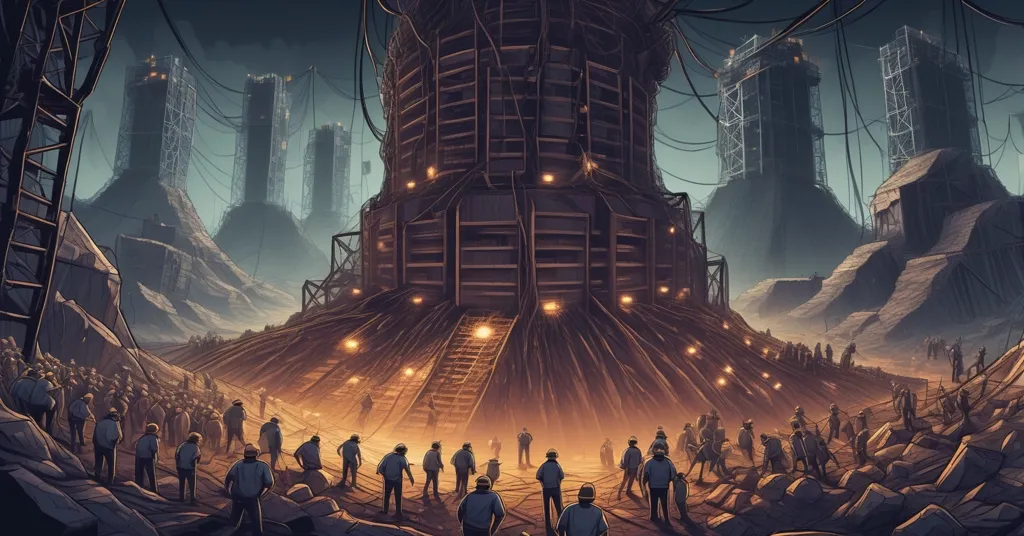Bitcoin Mining Crisis: Centralization Threatens Decentralization in 2025

Bitcoin Mining Crisis: Is Decentralization Dead in 2025?
Bitcoin, the flagbearer of financial sovereignty and decentralized power, is teetering on the edge of a precipice. Its mining ecosystem, the bedrock of network security, is grappling with economic collapse and alarming centralization, casting doubt on whether BTC can still embody Satoshi Nakamoto’s vision of a peer-to-peer electronic cash system.
- Mempool Ghost Town: Bitcoin’s transaction backlog has sunk to 18-month lows, with fees barely a whisper of miner revenue.
- Miner Desperation: Economic strain forces miners to slash fee thresholds to 0.1 sat/vByte, while many flee to AI data centers or hoard BTC.
- Centralization Alarm: Three mining pools dominate nearly 60% of hashrate, as corporate giants like Tether tighten their grip.
Mempool Meltdown: Why Transactions Are Drying Up
Bitcoin’s mempool—the waiting room for unconfirmed transactions—is quieter than a crypt on a Monday morning. Recent figures show pending transactions hovering at a measly 5,000 on slower days, peaking at just 15,000, a far cry from the 150,000 backlog when BTC soared past $100,000 in late 2024. This isn’t a quirk; it’s a glaring symptom of shrinking retail usage, as explored in this detailed analysis of Bitcoin mempool activity decline in 2025. Most folks aren’t using Bitcoin for everyday peer-to-peer exchanges anymore. Instead, it’s being stockpiled by corporate treasuries as a glitzy store of value, leaving miners—who rely on transaction fees as block rewards dwindle after each halving—stranded in a revenue desert.
Transaction fees now make up less than 1% of miners’ income, a dire threshold last seen during the savage crypto winter of 2022, even as BTC’s price dances near all-time highs. Expert Joël Valenzuela calls this a “major crisis,” warning that Bitcoin risks morphing into a centralized entity puppeteered by governments and institutions. For miners, the math just doesn’t add up: with block rewards halving every four years (cutting the payout for mining a new block in half), fees were supposed to be the lifeline. But with so few transactions to process, that lifeline is fraying fast.
Miner Exodus: Economic Crunch Hits Hard
In a bid to survive, miners have slashed their minimum fee standards from 1 satoshi per virtual byte (sat/vByte—a unit measuring transaction data size) to a desperate 0.1 sat/vByte. Pools like SpiderPool are leading this capitulation, practically pleading for any scrap of revenue to keep their rigs running. But for many, even that’s not enough. Some are abandoning Bitcoin mining entirely, pivoting to steadier gigs like powering AI data centers. Who’d have thought Bitcoin miners would rather crunch numbers for tech overlords than secure the world’s most rebellious currency?
Others are taking an even stranger route: buying BTC outright for their treasuries instead of mining it. It’s a surreal flip—guardians of the network turning into passive holders. June 2025 production reports lay bare the carnage. MARA mined just 713 BTC, down from 950 in May, while Riot Platforms dropped to 450 from 514. CleanSpark held at 685 BTC, a slight dip, and Iris Energy (620 BTC) is leaning on AI cloud services for a $2.2 million side hustle. Bitdeer and Hive Digital eked out small gains at 203 and 164 BTC, but Cipher Mining (160 BTC) and Canaan Inc. (88 BTC) stumbled, hit by weather-related outages in Texas that forced operational cuts. Core Scientific and Bit Digital are outright exiting mining focus, and Hut 8 is transferring operations to American Bitcoin Corp, a firm with Trump ties eyeing a Nasdaq listing. This isn’t just a rough patch; it’s an existential reckoning.
Centralization Creep: Who Controls Bitcoin’s Power?
Now let’s talk about the elephant in the room: centralization. Bitcoin’s hashrate—the computational muscle securing the network—is increasingly concentrated in a few hands. Three mining pools, Foundry USA, AntPool, and ViaBTC, command nearly 60% of the total, with Foundry at 30%, AntPool at 19%, and ViaBTC at 14.5%. F2Pool, at 10%, isn’t far behind in the rankings, as shown in this Bitcoin mining pools hashrate distribution breakdown. For context, if any group controls over 51% of hashrate, they could, in theory, tamper with transactions or double-spend coins, shattering the trust that makes Bitcoin tick. Back in May 2017, the top two pools held less than 30% of hashrate; today, Foundry and AntPool alone often flirt with half, and when you count proxy pools (smaller outfits relaying work under big names like “AntPool & friends”), some estimates peg their grip at 60-70%. This isn’t decentralization; it’s a blatant oligarchy.
The players behind this power grab aren’t anonymous coders in garages. Foundry USA is owned by Digital Currency Group (DCG), a crypto titan whose CEO, Barry Silbert, faces accusations of fraud from creditors of its bankrupt lending arm, Genesis Capital. One creditor pulled no punches:
“Silbert and his cronies… recklessly operated, exploited, and then bankrupted Genesis following a spectacular campaign of fraud and self-dealing.”
Meanwhile, AntPool is run by Bitmain’s Jihan Wu, whose firm controls 90% of the ASIC mining rig market—a near-monopoly on the hardware miners need. Add in underreported hashrate from AntPool’s proxy pools like Poolin and Braiins, and the centralization picture gets even uglier, as discussed in this report on mining centralization trends for 2025. This setup is a far cry from Satoshi’s 2008 blueprint of a distributed, trustless system.
Corporate Takeover: Tether and Wall Street Move In
While miners bleed out, corporate heavyweights are swooping in to reshape Bitcoin’s landscape. Tether, the stablecoin giant behind USDT, is gunning to be, in CEO Paolo Ardoino’s words, “the biggest Bitcoin miner in the world” by year’s end. They’ve dropped $600 million for a 70% stake in Adecoagro S.A., a South American agribusiness, to harness renewable energy from agricultural ops for mining, as detailed in this update on Tether’s expansion into South American mining. Adecoagro’s chairman, Juan Santori, framed it as:
“A new intersection between agriculture, energy, and technology.”
Let’s be real—Tether’s farming more than just stablecoins; they’re planting seeds for mining dominance with literal crops. They also hold a 25% stake in miner Bitdeer and plan to funnel hashrate to the decentralized pool Ocean, though that’s a small gesture against their broader power play, further explored in this piece on Tether’s impact on Bitcoin mining dominance. Green energy is a nice PR spin, but when one entity amasses such influence, centralization risks loom large.
Then there’s Blockstream’s Adam Back, once a cypherpunk hero, now in talks for a $3 billion BTC treasury deal with Wall Street’s Cantor Fitzgerald. Back once said:
“Individuals using a peer to peer ecash, are the very reason for existence of Bitcoin.”
Yet here he is, brokering deals that critics slam as turning BTC into “a completely custodial asset run by governments and institutions.” Corporate treasuries like MicroStrategy’s—eclipsing even MARA’s 49,940 BTC—further sideline retail users. Bitcoin as a middle finger to the system? That dream’s looking more like a handshake with the suits.
Historical Echoes and Structural Flaws
This isn’t Bitcoin’s first brush with centralization. Back in 2014, GHash.IO briefly controlled over 51% of hashrate, sparking community outrage and a push for diversification that temporarily eased the threat. Today’s crisis feels more entrenched, rooted in structural choices from the 2017 scaling wars. Bitcoin Core, the group maintaining BTC’s software, opted for tiny block sizes, limiting how many transactions fit in each block. Smaller blocks mean fewer transactions processed at once, capping the fees miners collect—a chokehold on their income that’s biting hard now. Satoshi envisioned fees sustaining the network as halving events shrink block rewards, but with retail transaction density near zero, that vision is crumbling, as highlighted in this overview of Bitcoin mining centralization issues.
Geopolitical undercurrents add another layer. Nations like Russia and Venezuela are leveraging crypto to skirt sanctions, and Tether’s stablecoin USDT could play a role in cross-border commodity trades—faster and cheaper than traditional systems, as expert Marcos Viriato notes. This could bolster Bitcoin’s censorship-resistant appeal, but if state-backed or corporate-controlled mining grows, it might just swap one form of centralization for another.
Counterpoints: Is Centralization Inevitable or Beneficial?
Let’s play devil’s advocate for a moment. Some argue a degree of centralization might be inevitable, even helpful, for Bitcoin’s stability and growth. Larger pools can invest in cutting-edge hardware and renewable energy, potentially securing the network more efficiently than scattered solo miners. Figures like Adam Back might claim institutional involvement—via treasuries or mining—lends Bitcoin mainstream legitimacy, drawing capital to fuel innovation. But here’s the rub: efficiency at the cost of decentralization risks turning Bitcoin into just another TradFi asset, vulnerable to manipulation or regulatory capture. A 51% attack isn’t just a theory; it’s a dagger hanging over trust in the system, a concern echoed in community discussions like this thread on decentralization concerns. Satoshi didn’t build Bitcoin to be a Wall Street toy, and no amount of “stability” justifies that betrayal.
Paths Forward: Can Bitcoin Reclaim Its Roots?
There’s no easy fix, but glimmers of hope exist. Supporting smaller pools like MARA Pool (at 5% hashrate) or pushing large US miners to solo mine—running independent operations instead of joining mega-pools—could dilute centralization. Decentralized pools like Ocean, though currently under 1% of hashrate, offer a model for redistributing power with community-driven protocols. Incentivizing these through fee structures or open-source tools might spark change, though scaling such efforts is a slog.
Retail re-engagement is another linchpin. Why have everyday users drifted? High fees in past bull runs, clunky user experiences, and altcoin competition—think Ethereum’s DeFi ecosystem—have siphoned transactional activity. Solutions like the Lightning Network, a second-layer scaling tool for faster, cheaper BTC payments, or better wallet designs could lure small investors back. Expert Joao Wedson suggests mempool activity is a litmus test for network health; a spike in transaction density would signal retail revival and bolster miner revenue. Community education on Bitcoin’s P2P ethos might also reignite grassroots passion, though reversing the corporate tide feels like swimming against a tsunami, a sentiment shared in this discussion on centralization’s impact on Bitcoin mining.
Tether’s moves, while risky, hint at untapped potential. Their pivot to commodities trading—using USDT for cross-border deals or even tokenizing assets like sugar, as speculated by Gracy Chen—could bridge crypto with real-world markets. If done transparently, this might expand Bitcoin’s utility beyond “digital gold.” But without checks on their mining ambitions, it’s just another power grab dressed in green energy garb.
Key Takeaways and Questions for Bitcoin’s Future
- What’s driving the collapse of Bitcoin’s mempool activity?
Retail usage is drying up as BTC becomes a corporate store of value rather than peer-to-peer cash, leaving fewer transactions for miners to process. - Why are Bitcoin miners struggling despite record-high prices?
Transaction fees, vital as block rewards halve, are under 1% of revenue due to low activity, forcing miners to accept pitiful rates or exit entirely. - How does mining centralization threaten Bitcoin’s principles?
With three pools controlling nearly 60% of hashrate, the risk of a 51% attack or network manipulation grows, undermining the decentralized trust model. - What are miners doing to weather this economic storm?
Many pivot to AI data centers, buy BTC for treasuries, or quit mining, while giants like Tether expand with renewable energy strategies. - Is Tether’s mining push a help or hindrance to Bitcoin?
It’s a double-edged sword—sustainable energy is positive, but their drive for dominance could centralize power further in few hands. - Has Bitcoin lost sight of its original mission?
Critics say yes, pointing to its custodial shift under institutional control and Bitcoin Core’s scalability limits as deviations from P2P cash. - Can retail users save Bitcoin’s decentralization?
A return of small investors driving transaction volume could strengthen miner income and network health, though reversing current trends is uncertain. - What might Bitcoin’s mining landscape look like in five years?
If centralization persists, BTC could become a corporate asset; if solutions like solo mining or retail revival take hold, it might reclaim some distributed power.
Bitcoin is at a pivotal juncture. The mempool emptiness, miner capitulation, and hashrate monopolies aren’t mere glitches—they’re warning sirens of a network drifting from its rebel roots, a point sharply made in this critique of Bitcoin’s decentralization challenges. Yet, the fight isn’t over. Smaller pools, solo mining, and retail resurgence could shift the tide, while innovations from players like Tether might open new frontiers—if kept in check. As believers in Bitcoin’s promise, we critique because we care. Its potential as the cornerstone of decentralized finance still burns bright, but only if the community acts to preserve what made it revolutionary. Ignoring these cracks won’t just risk a fall; it’ll guarantee one.



